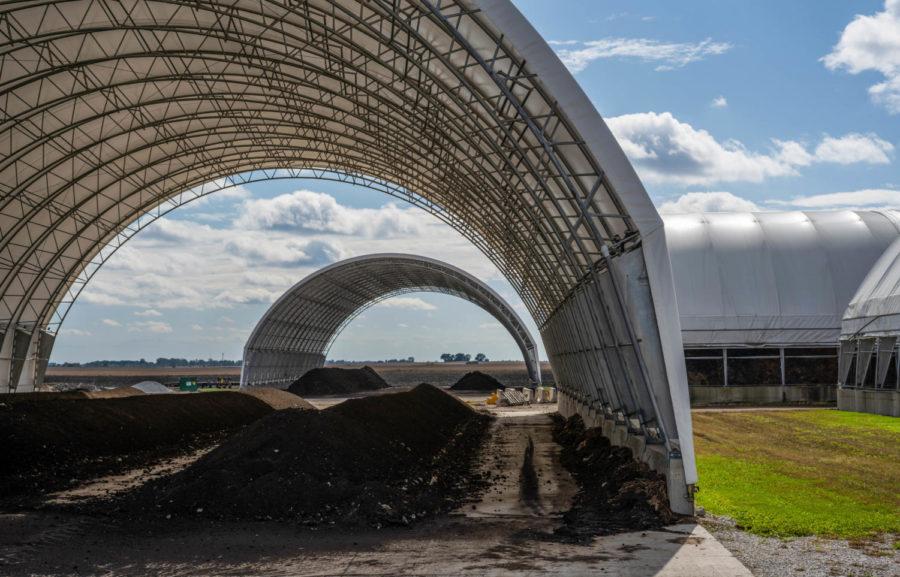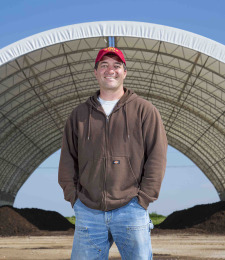In 2008 Iowa State University constructed a facility for composting organic waste materials from several campus sources. The facility is designed to handle more than 10,000 tons of organic wastes annually and is located west of the Dairy Farm, which is south of the Iowa State campus.
Compost

Iowa State University Compost Facility
The University Compost Facility was built in 2008 with the initial purpose of managing manure produced by the ISU Dairy Farm's 400+ milking cows. In the years since, however, the University Compost Facility has made an ongoing commitment to expand its relationships with other campus entities: ISU Dining began composting food waste from its catering services and residential dining facilities in 2009, while Jack Trice Stadium began composting food waste from its suites in 2010. Although manure still accounts for nearly 80% of the site's incoming material, the University Compost Facility currently has the capacity to receive up to 10,000 tons per year of animal bedding, landscaping waste, food waste and biomass research waste from ISU Campus Services, Reiman Gardens, Animal Science Farms, Research and Demonstration Farms, ISU Dining, and Biocentury Research Farm.
After initial collection, nitrogen-rich manure and food waste are mixed together with carbon-rich corn stover and yard waste, which is then formed into piles that are turned and aerated periodically to promote decomposition and minimize odor. To reduce the risk of runoff and leaching, finished compost is cured and stored under the cover of large hoop barns. Using this process, campus waste usually takes four months to transform into compost. The resulting product is used for agricultural research and landscaping projects, exemplifying a full-circle model of sustainability that meets 100% of Iowa State's compost needs. In 2019, for example, the site converted 9,275 tons of waste into 3,970 tons of material used exclusively for campus purposes.
As part of the ISU Research and Demonstration Farms, the University Compost Facility produces an annual report on its progress and accomplishments. Although only those affiliated with ISU can bring materials into or out of the site, tours are available to the general public.
See the dropdowns below to see how composting is making an impact within each of the three facets of sustainability. Contact ISU Compost site manager Steve Jonas via email at sjonas23@iastate.edu.

We recycle a lot of waste that would end up in a landfill or just pile up somewhere. Eventually that waste turns into something beneficial that can help make our campus better.
Steve Jonas, University Compost Facility Manager
- With the material provided by the University Compost Facility, this low-cost program saves money and prevents Iowa State from purchasing compost from outside sources. ISU's compost is mostly used for landscaping projects and agricultural research.
- The University Compost Facility charges a small fee for material that goes in and out of the site. This enables the facility to operate as a self-sustaining operation that can pay for its own maintenance and labor.
- In addition to a full-time manager, the University Compost Facility also employs several students to work at the site.
- The University Compost Facility continually assesses ways to improve its site to become more economically efficient. For example, the facility is currently upgrading the roofs of all its warehouses to better manage snow, which is the single biggest composting challenge at Iowa State, as it can be difficult to maintain microbes and warmth in the compost during winter.
- Upon initial collection, nitrogen-rich manure and food waste are mixed with carbon-rich corn stover and yard waste to make windrow piles. This mix balances carbon and nitrogen at the correct moisture and density to promote aerobic microbial decomposition. The windrows are turned and aerated twice a week to promote composting and minimize odor. To reduce the risk of runoff and leaching, finished compost is cured and stored under the cover of large hoop barns. Using this process, campus waste usually takes four months to transform into compost.
- According to the EPA, food scraps and yard waste currently make up 20-30% of what Americans throw away. Composting keeps these materials out of landfills where they take up space and release methane, a potent greenhouse gas that contributes to climate change.
- In providing an alternative to chemical fertilizers, compost enriches soil, retains moisture, suppresses plant diseases, protects against pests and encourages the production of beneficial bacteria and fungi that break down organic matter to create humus, a rich, nutrient-filled material.
- Although the University Compost Facility receives the bulk of its waste from campus partners, student groups and departments, through collaboration with ISU Catering and ISU Recycling Services, can also divert food waste, resulting from campus and community events, to the facility, instead of being landfilled.
- The University Compost Facility has ongoing relationships with the many campus entities, representing a variety of connection to supporting community including: ISU Dining, ISU Campus Services, Reiman Gardens, the Jeff and Deb Hansen Agriculture Student Learning Center, the Agricultural Engineering/Agronomy Farm, the BioCentury Research Farm, the Horticulture Research Station, the USDA North Central Region Plant Introduction Station and the Animal Science Beef, Dairy, Sheep, Swine, Poultry and Equine farms.
- Of the eight on-site hoop barns, one is used for making compost for organic agriculture research projects. In collaboration with the Agronomy Department, the University Compost Facility meets the USDA's national guidelines for organic compost to ensure researchers can use this material for their organic projects.
- To share its knowledge, the University Compost Facility regularly conducts tours and on-site presentations. In the past it has hosted the Iowa Department of Natural Resources, the Ames Chamber of Commerce, visitors from other countries and school groups of all ages.